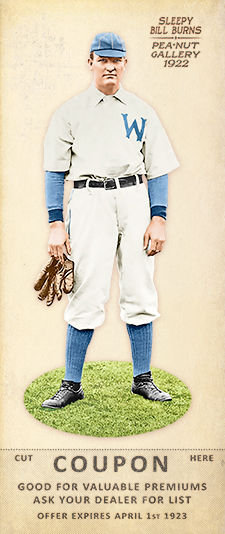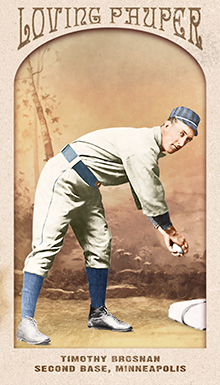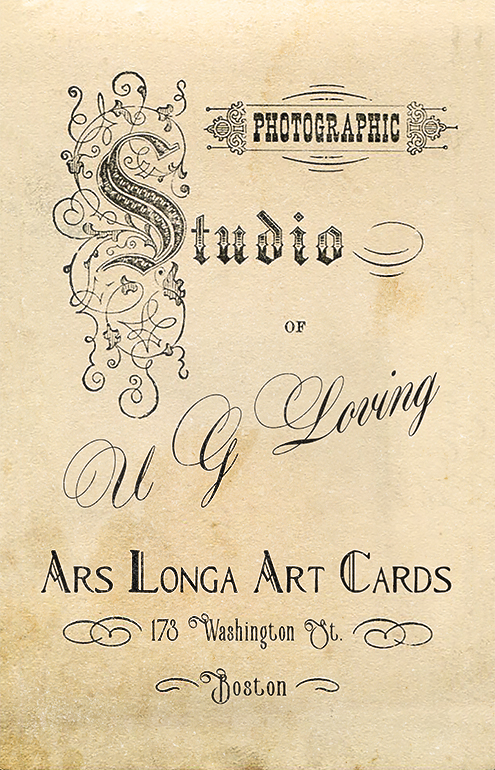
- Series: 1919 Black Sox Scandal
- City: Washington, D.C.
- Team: Senators
- League: American League
William Thomas Burns (1880-1953) was an American League pitcher who didn’t finish well. He began his career of failed finales in his rookie season, 1908, with the Washington Senators. Bill took a no-hitter into the ninth inning and got two more outs before Germany Schaefer spoiled his bid and won the game. A year later with the White Sox, and facing his former teammate Walter Johnson, Burns lost another no-hitter with one out to go. Not until Dave Stieb had the misfortune of losing (consecutive!) two-out no-nos in 1988 would such a fate befall another major leaguer. The ‘08 season was a fine one for Bill, who apparently didn’t earn his “Sleepy” sobriquet until later, when he developed a reputation for a lackadaisical demeanor on the mound. He had an outstanding 1.69 ERA in 1908, but would never win more than eight games in a season en route to a 30-52 career record.
It was his career-ending tour with the Tigers in 1912 that would prove fateful for Sleepy Bill. On May 18, teammate Ty Cobb couldn’t resist battering a maimed and abusive fan, earning a suspension from league president Ban Johnson and triggering a walk-out by the team. Detroit’s owner wanted to forfeit and Johnson threatened to fine him if he didn’t field a team in Philadelphia. Thus Burns crossed paths with Billy Maharg, who was one of the replacement players against the Athletics. Years later, the two would team up in a scheme that provided the most notorious of endings for Bill Burns: the end of any reputation for honor in baseball. He and ex-boxer, and shadowy operator Maharg, likely at the behest of the most famed gambler of his day, Arnold Rothstein, would fix the 1919 World Series. Burns met with Eddie Cicotte and Chick Gandil at a New York hotel prior to the postseason. Investigation later revealed that Burns acted with Rothstein’s chauffeur, Maharg, and claimed to be representing someone known as “A.R.” For all of the rumors and speculation surrounding the Black Sox scandal, one bit of testimony was clear. Burns told the Assistant State Attorney: “I had the hundred thousand dollars to handle the throwing of the World Series. I also told them that I had the names of the men who were going to finance it.”
- Sleepy Bill, known for carelessness as a pitcher, was a willing henchman to the biggest crime lord of the era. He displayed a carelessness for the truth, for morality and integrity, forever staining America’s Pastime
- Another footnote to the Black Sox: Jean Dubuc was a player on the 1919 New York Giants (and had also been on the 1912 Tigers). Despite having an excellent year for the Giants in 1919, John McGraw released Dubuc, unexpectedly and without explanation, before the 1920 season. Dubuc then left the country to play and, in retrospect, lay low in Canada for 1921, and returned to play minor league ball in the States in 1922, but would never again play in the major leagues. When asked later why he had released Dubuc, McGraw stated that Dubuc "constantly associated" with Sleepy Burns and suspected that the two of them, along with Hal Chase, had conspired to ensure the Giants would lose out to the Reds during the 1919 pennant chase. Further raising suspicions of Dubuc's complicity in the year-end gambling scandals of 1919, his former Giants teammate Rube Benton testified in court during the Black Sox hearings that Dubuc had been tipped to the world series' fix by an anonymous telegram that urged him to place bets on the Reds. Combining that testimony with McGraw's suspicions, many (including The Sporting News) considered Dubuc's "guilty knowledge" of the fix as evidence of conspiracy equal to that of some other scandal participants, such as Buck Weaver and Joe Jackson, but Jean Dubuc somehow escaped such judgement from Kenesaw Mountain Landis and was never formally banned from professional baseball. Dubuc would hence go on to have a successful career as a scout for the Detroit Tigers, signing Birdie Tebbetts and Hank Greenberg. Nobody knows who sent Dubuc that anonymous telegram in 1919, but the most common candidate proposed by historians is Sleepy Bill Burns.

- Series: Athletic of Philadelphia: 1874
- City: Philadelphia
- Team: Athletics (NAPBBP)
- League: National Association (NAPBBP)
Joseph V. Battin (1853-1937) was a scrappy infielder for three National Association teams from 1871-75, remaining with the St. Louis Brown Stockings as they joined the new NL in ‘76. He began with the Cleveland Forest Citys in 1871 at the age of 17, playing just one game in the outfield. After a year off, Joe returned to pro ball with the Athletics in ‘73, again getting into only one game. He caught on the following season, managing to hit .230 for the A’s across 51 games before shipping out to St. Louis for the ‘75 campaign.
Joe's second season in St. Louis, the National League's inaugural season of 1876, was his best as he hit .300 (with a 135 OPS+) in 64 games. He slumped the next year and the Browns sent him to the Alleghenys of Pittsburgh. Joe rarely hit above .200 thereafter and would spend more time in the minors than the majors over the balance of his career.
The 1880s were a time of movement for players and even teams and leagues. But few may have had as head-spinning a season as Joe in 1885. He found himself playing for five teams, three in Waterbury, CT, and each of those in a different league! He began the season with Waterbury’s Southern New England League entry, went back out to Cleveland’s Forest Citys, now in the Western League, back to Waterbury’s Brassmen of the Connecticut State League, up to Binghamton of the New York State League, and finally back in CT with Waterbury’s Eastern League squad.
- Joe got one last shot of big league glory with the Syracuse Stars in 1890, hitting .210 in 29 games
- Battin appeared on the first Hall of Fame ballot in 1936. He received one vote from the Veteran's Committee, tying him with 22 other players including Jake Beckley, Tommy McCarthy, Bobby Wallace, Jesse Burkett, Deacon White & Tim Keefe, and surpassing Candy Cummings who received zero votes
- Series: 1873 Boston Red Stockings Team Cab
- City: Boston
- Team: Red Stockings (NAPBBP)
- League: National Association (NAPBBP)
- Hall: National Baseball Hall of Fame
Description under construction.

- Series: Mort's Reserve
- City: Boston
- Team: Red Stockings (NAPBBP)
- League: National Association (NAPBBP)
Charles Roscoe Barnes (1850-1915) was the best player in the five year history of the fist professional baseball league, the National Association of Professional Baseball Players (NAPBBP), 1871-1875. Barnes is the all-time NAPBBP leader in runs, hits, doubles, walks, stolen bases, total bases, batting average, OBP and SLG%. He then dominated the National League in its inaugural year, 1876, leading the league hits, runs, average, OBP, SLG%, total bases, doubles, triples and walks. He also hit the 1st HR in National League history, for the Chicago White Stockings, 5.2.1876. Over the first six years of his major league career, Barnes' batting average was .397. An unidentified illness limited Barnes to just 22 games in 1877, and he was never the same player again, retiring shortly thereafter at the age of 31.
“Roscoe C. Barnes…was the greatest second baseman the game ever had…” - A History of the Boston Baseball Club, 1897.
"No matter how great you were once upon a time — the years go by, and men forget. Ross Barnes, forty years ago, was as great as Cobb or Wagner ever dared to be. Had scores been kept then as now, he would have seemed incomparably marvelous.” - W.A. Phelan, Baseball Magazine, 1915
- Because he played in the second game in MLB history, is credited with the 17 other players that day as the 27th player to debut in MLB
- 1st hitter to win batting titles in 2 leagues: NA in ’72-73 and NL in ‘76
- In 1918, made Cap Anson’s all-time team as the shortstop
- Barnes was selected as SABR’s ”Overlooked 19th Century Baseball Legend “ for 2013

- Series: 1880s: Loving Paupers
- City: Minneapolis
- Team: Millers
- League: Western Association
Timothy J. Brosnan spent his entire professional baseball career in the minors, primarily as a second baseman. His first recorded teams, in 1884, were Springfield of the Massachusetts State Association and Rockville of the Connecticut State League. He moved to Lawrence of the Eastern New England League in '85 and also played for Brockton of the New England League. He was moving up in class at Lawrence where ten of his sixteen known teammates would see action in the majors. His stint at Brockton put Brosnan into even more elite company. Bill McGunnigle, who would go on to a managerial role in Brooklyn, was a pitcher/outfielder and Tommy Bond, then on the downside of a fine career in Boston, was a Brockton mainstay in the pitcher's box. In all, nearly two dozen of the '86 squad had been or would be big leaguers. 1886 was a significant dividing line in Tim's pro tenure. He left New England for the Southern Association's Charleston club. He played in the most games of any on the Seagulls despite a struggling .228 average. The following year saw Brosnan move to the midwest where he would conclude his professional endeavors. Tim joined the Des Moines Hawkeyes for the '87 campaign and again proved his durability, leading the team with 123 games played and compiling a very fine .317 average. With the Minneapolis Millers in '88 Brosnan's average declined to .254 but he was a regular. Tim's final move took him to Sioux City later that season and he would remain a Corn Husker for the final two years of his career.
- Brosnan hit .275 in '89, his last full year
- Tim was captured by the Old Judge crew in 1888 in his Millers' uniform — six poses depicting a right-hander at bat and afield
Auction History
Cartophilia
Old Judge Pose: 41-2





